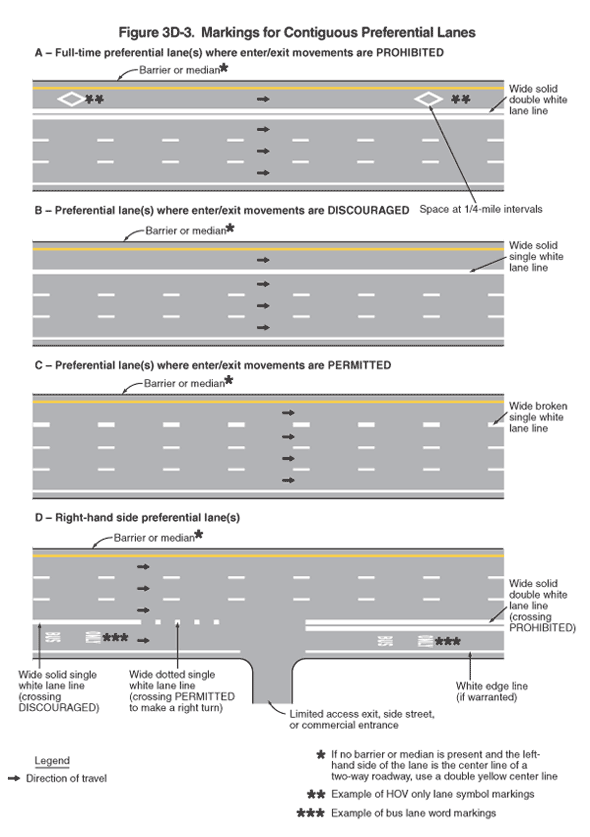|
|
2009 Edition Part 3 Figure 3D-3. Markings for Contiguous Preferential Lanes

Figure 3D-3. Markings for Contiguous Preferential Lanes
This figure illustrates four examples of markings for contiguous preferential lanes.
Four horizontal roadways are shown, A, B, C, and D. A legend shows a black arrow indicating the direction of travel in the lanes.
- Figure A is labeled "Full-time preferential lane(s) where enter/exit movements are PROHIBITED." The figure shows a four-lane roadway. A solid yellow line separates the left travel lane from a shoulder, a solid white line separates the right travel lane from a shoulder, and a broken white line separates the three rightmost lanes from each other. The left shoulder is bordered on the outside by a line labeled "barrier or median" with a note that states: "If no barrier or median is present and the left-hand side of the lane is the center line of a two-way roadway, use a double yellow center line." Arrows indicate that the direction of travel is from the left of the figure to the right. The leftmost preferential lane is shown separated from the other three by a wide solid double white lane line. White elongated diamonds are shown marked on the pavement of the left preferential lane with the note: "Space at 1/4-mile intervals." These markings are noted as an example of HOV only lane symbol markings.
- Figure B is labeled "Preferential lane(s) where enter/exit movements are DISCOURAGED." The figure shows the same four-lane roadway as in figure A, except the leftmost preferential lane is shown separated from the other three by a wide solid single white lane line and no HOV symbols are shown on the pavement.
- Figure C is labeled "Preferential lane(s) where enter/exit movements are PERMITTED." The figure shows the same four-lane roadway as in figure A, except the leftmost preferential lane is shown separated from the other three by a wide broken single white lane line and no HOV symbols are shown on the pavement.
- Figure D is labeled "Right-hand side preferential lane(s)." The figure shows a four-lane horizontal roadway with a vertical roadway intersecting the rightmost lane. The vertical roadway is labeled as a "limited access exit, side street, or commercial entrance." A solid yellow line separates the left travel lane from a shoulder, a solid white edge line separates the right travel lane from a shoulder, noted "if warranted," and a broken white line separates the three leftmost lanes from each other. The left shoulder is bordered on the outside by a line labeled "barrier or median" with a note that states: "If no barrier or median is present and the left-hand side of the lane is the center line of a two-way roadway, use a double yellow center line." Arrows indicate that the direction of travel is from the left of the figure to the right. On the left side of the figure, in advance of the intersection, the rightmost preferential lane is shown separated from the other three by a wide solid single white lane line. The solid single lane line is noted as "crossing DISCOURAGED." Closer to the intersection, the white lane line is shown changing to a wide dotted single white lane line, noted as "crossing PERMITTED to make a right turn." This line does not continue across the intersection with the vertical roadway. On the right side of the figure, on the east side of the intersection, the right preferential lane is shown separated from the other three by a wide solid double white lane line. The solid double lane lines are noted as "crossing PROHIBITED." In the right preferential lane, words are shown marked on the pavement in white on two lines, progressing in the direction of travel from the word "BUS" to the word "ONLY." These words are noted as an "example of bus lane word markings."
